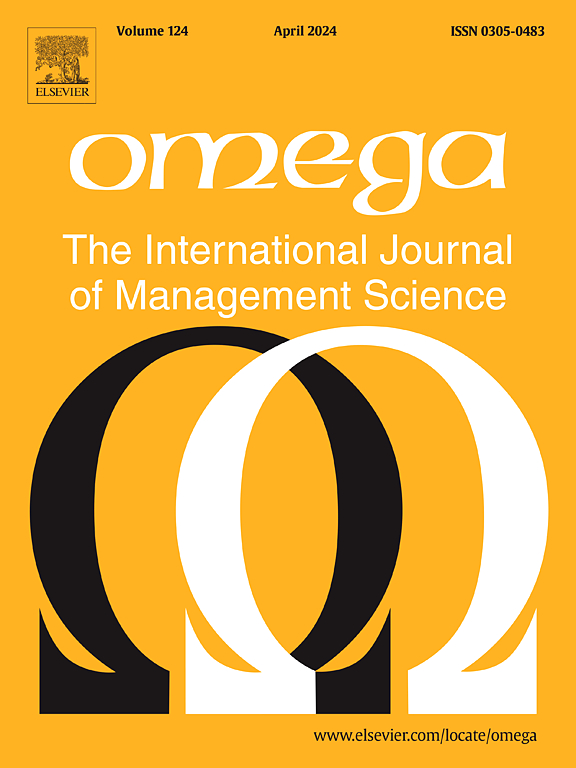An outranking relation built on an additive value function preference model: Creating synergy between both paradigms
IF 7.2
2区 管理学
Q1 MANAGEMENT
Omega-international Journal of Management Science
Pub Date : 2025-06-12
DOI:10.1016/j.omega.2025.103384
引用次数: 0
Abstract
In multiple criteria decision making, the additive value function model is useful for modeling weak-order preferences, quantitative information about criterion performance, and tradeoffs where disadvantages in some attributes can be compensated by improvements in others. However, major difficulties arise when the value function model must deal with ordinal information in some criteria, highly heterogeneous scales, unacceptably poor criterion performances, and threshold effects leading to intransitive preferences, issues that can be addressed by outranking methods. This paper aims to create synergy between these perspectives. Under certain conditions, the preference relation “at least as good as” can be represented by an additive multi-attribute value function on a subset of the decision set. The value function model can then be extrapolated out of this subset while retaining some information about the “worth” of alternatives which do not belong to it. By extrapolating the value function model and using some additional information, a transitive outranking relation (“the DM has sufficient reasons to justify that “x is at least as good as y and no strong reasons against”) can be defined on a wider subset of the decision set. Using the transitive outranking relation, methods for ranking and ordinal classification (recently called rating) problems are discussed, in which the transitivity of the relation is a valuable feature. Ordinal and measurable value functions are distinguished. In the latter case, the outranking relation is richer, so the cardinality of the incomparability relation could be greatly reduced.
建立在附加价值函数偏好模型上的超排序关系:在两种范式之间创造协同作用
在多标准决策制定中,附加价值函数模型对于建模弱顺序偏好、关于标准性能的定量信息以及权衡(某些属性的缺点可以通过其他属性的改进来弥补)非常有用。然而,当价值函数模型必须处理某些标准中的有序信息时,主要的困难就出现了,高度异构的尺度,不可接受的差标准性能,以及导致不可传递偏好的阈值效应,这些问题可以通过超越排序方法来解决。本文旨在建立这些观点之间的协同效应。在一定条件下,“至少一样好”的偏好关系可以用决策集子集上的加性多属性值函数表示。然后,价值函数模型可以从这个子集中推断出来,同时保留一些关于不属于它的替代方案的“价值”的信息。通过外推价值函数模型并使用一些附加信息,可以在决策集的更广泛子集上定义传递的超排序关系(“DM有足够的理由证明“x至少与y一样好,没有强有力的理由反对”)。利用传递超排序关系,讨论了排序和有序分类(最近称为排序)问题的方法,其中关系的传递性是有价值的特征。序数值函数和可测量值函数是有区别的。在后一种情况下,排名关系更为丰富,因此不可比较关系的基数性可以大大降低。
本文章由计算机程序翻译,如有差异,请以英文原文为准。
求助全文
约1分钟内获得全文
求助全文
来源期刊

Omega-international Journal of Management Science
管理科学-运筹学与管理科学
CiteScore
13.80
自引率
11.60%
发文量
130
审稿时长
56 days
期刊介绍:
Omega reports on developments in management, including the latest research results and applications. Original contributions and review articles describe the state of the art in specific fields or functions of management, while there are shorter critical assessments of particular management techniques. Other features of the journal are the "Memoranda" section for short communications and "Feedback", a correspondence column. Omega is both stimulating reading and an important source for practising managers, specialists in management services, operational research workers and management scientists, management consultants, academics, students and research personnel throughout the world. The material published is of high quality and relevance, written in a manner which makes it accessible to all of this wide-ranging readership. Preference will be given to papers with implications to the practice of management. Submissions of purely theoretical papers are discouraged. The review of material for publication in the journal reflects this aim.
 求助内容:
求助内容: 应助结果提醒方式:
应助结果提醒方式:


